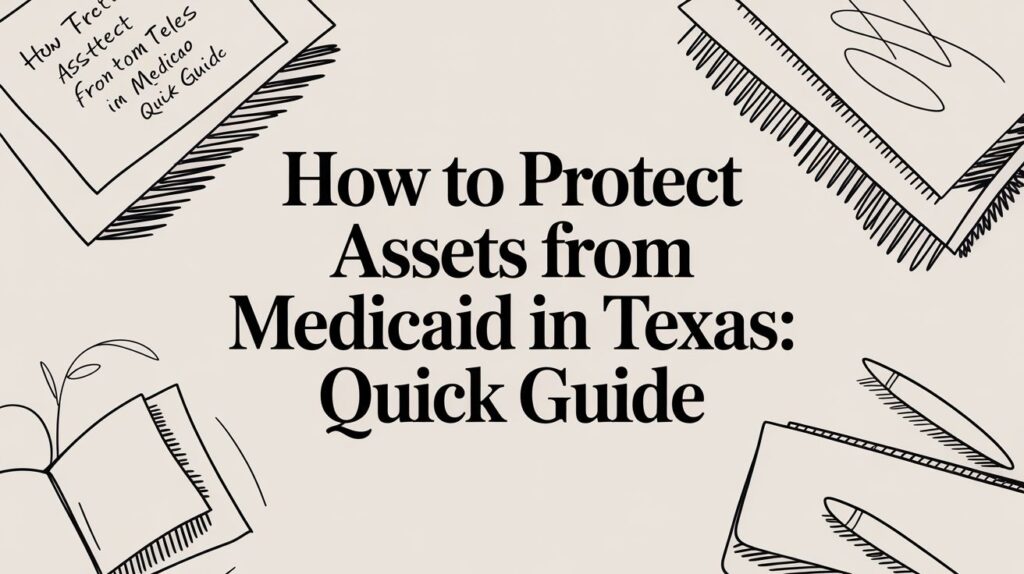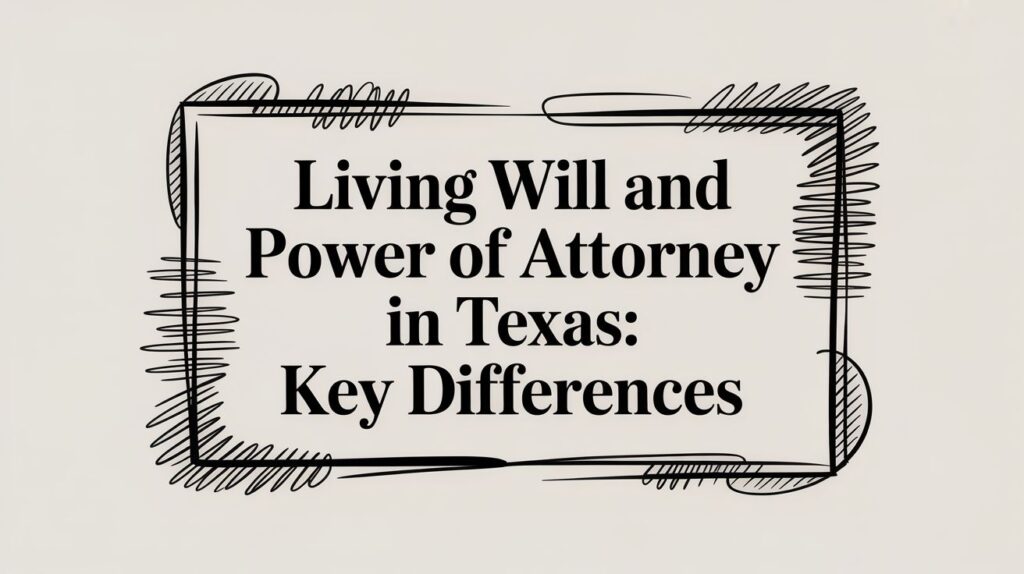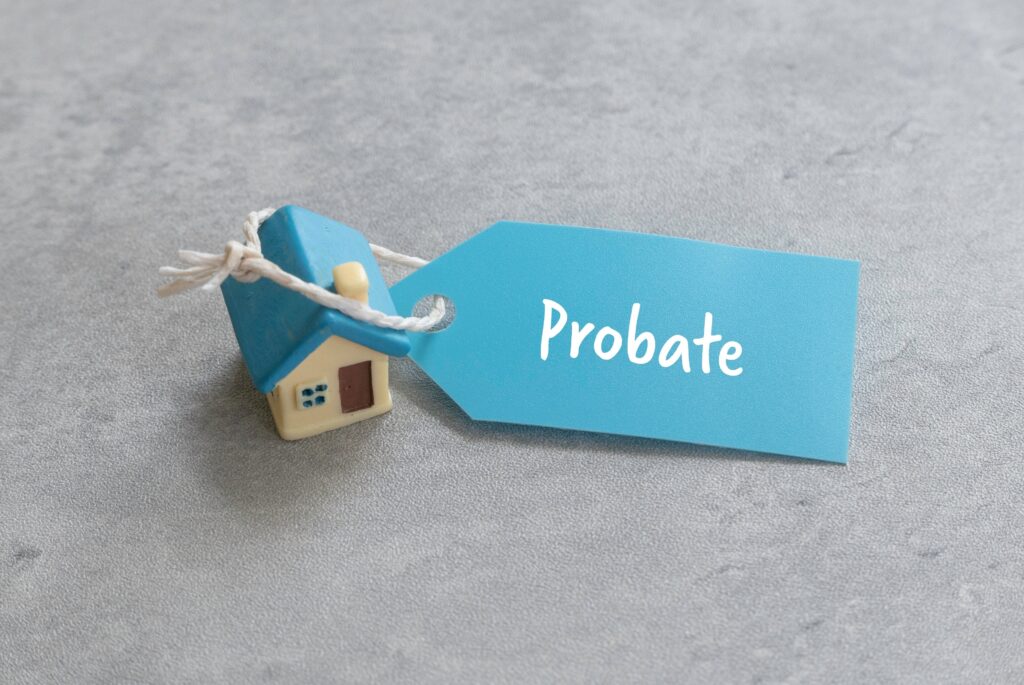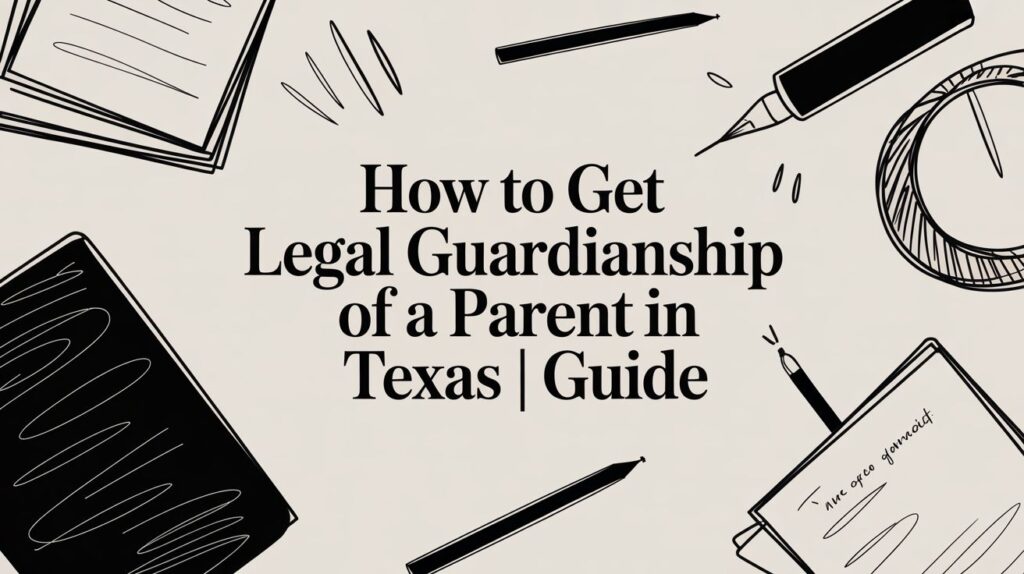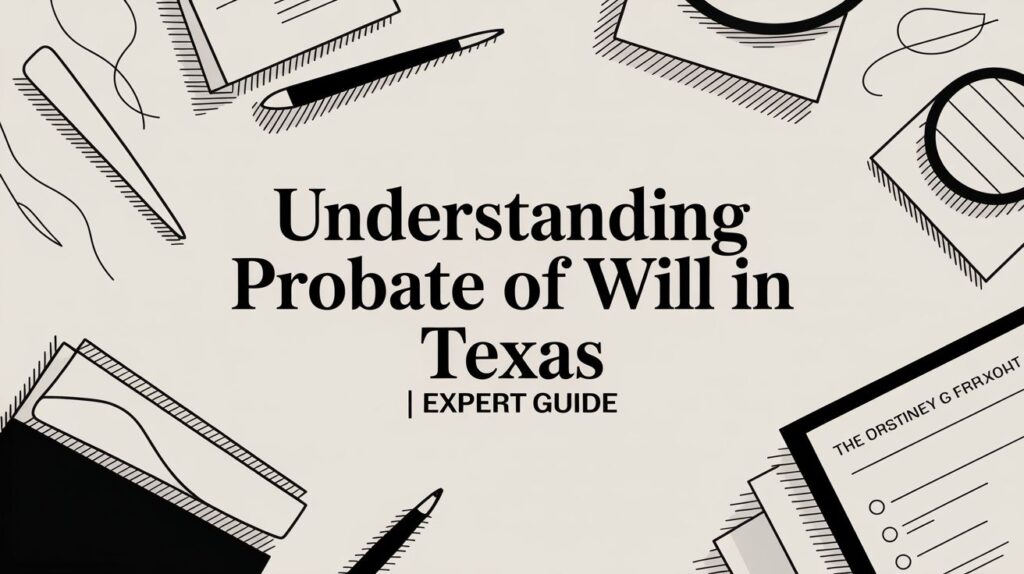When you realize a loved one might need long-term care, the emotional weight is heavy enough. Then comes the financial reality, and for many Texas families, it’s a gut punch. The key to weathering this storm is knowing how to protect your assets from Medicaid's strict rules, and that often means using proactive legal strategies like trusts, strategic gifting, and permissible spend-downs.
These aren't just financial maneuvers; they're tools to safeguard the savings you've worked a lifetime to build, ensuring your family's legacy is preserved for future generations.
Why Medicaid Planning Is Essential for Texas Families
The honest reason most families dive into Medicaid planning is the staggering cost of long-term care. When a parent or spouse needs nursing home care or round-the-clock assistance at home, the bills can wipe out a family's life savings in a shockingly short amount of time. We understand this is a sensitive and stressful time, and our goal is to provide clear, reassuring guidance.
In Texas, it's not uncommon for a private room in a nursing home to cost over $7,000 per month. That's more than $84,000 a year. Most families simply can't sustain that. For a deeper look into this financial challenge, it's worth reading a comprehensive guide to planning for long-term care.
This is exactly why Medicaid exists—to step in when those costs become impossible. But to get that help, you have to meet their rigid income and asset limits. Without a plan, you could be forced to spend down nearly everything you own just to become eligible.
This is where proactive planning becomes a necessity, not a luxury. It’s about taking control of your financial future before a health crisis dictates it for you.
Understanding Countable vs. Exempt Assets
The first step in protecting your assets is learning to see them the way Medicaid does. In plain English, the program sorts everything you own into two buckets: countable and exempt.
-
Countable Assets: These are the resources Medicaid fully expects you to use for your care before they'll pay a dime. Think checking and savings accounts, stocks, bonds, mutual funds, and that vacation cabin you own. For a single person in Texas, the limit for countable assets is a stark $2,000.
-
Exempt Assets: These are assets that, for policy reasons, Medicaid agrees not to count against you. The most common examples are your primary home (up to a certain equity value), one vehicle, your personal belongings, and pre-paid funeral arrangements.
This distinction is the entire foundation of Medicaid planning. The goal is to legally and ethically restructure your finances to shift assets from the "countable" column to the "exempt" one—or to move them out of your name entirely, long before you need to apply for benefits.
Texas Medicaid Asset Snapshot Countable vs. Exempt
To make this clearer, here's a quick reference table. It’s a simple way to start identifying which of your assets might be at risk and which are generally protected under Texas Medicaid rules.
| Asset Type | Generally Countable by Medicaid? | Key Texas Considerations and Notes |
|---|---|---|
| Primary Home | No (Exempt) | Protected up to an equity limit (currently $713,000 in 2024). It loses its exempt status if you don't intend to return home. |
| Checking/Savings Accounts | Yes (Countable) | All funds in these accounts count toward the $2,000 limit for an individual. |
| Stocks, Bonds, Mutual Funds | Yes (Countable) | The fair market value of these investments is fully countable. |
| One Vehicle | No (Exempt) | One car or truck of any value is typically exempt for the applicant or their spouse. |
| Vacation Home/Rental Property | Yes (Countable) | Any real estate other than your primary residence is a countable asset. |
| Pre-Paid Funeral Plan | No (Exempt) | Irrevocable pre-paid funeral contracts are exempt, a common spend-down tool. |
| Personal Belongings | No (Exempt) | Furniture, clothing, and household goods are not counted. |
This table is just a starting point. The rules can get complicated, especially when a spouse is involved, but it gives you a clear picture of where to focus your planning efforts.
The Role of Medicaid Estate Recovery
Here’s a detail many families miss until it’s too late: the Medicaid Estate Recovery Program (MERP). Even if your home is exempt while you're alive and receiving benefits, that protection isn't permanent.
After a loved one passes away, MERP allows the state of Texas to make a claim against their estate to get reimbursed for the money spent on their care. This is a provision under the Texas Estates Code, Title 2. It means the state can force the sale of your house to pay back the debt, wrecking any plans you had to pass it on to your children. This program can have a devastating impact of Medicaid Estate Recovery on Texas probate proceedings, and understanding it is critical.
Once you grasp these core ideas, the path forward becomes much clearer. It’s all about making informed decisions now to give your family financial security and peace of mind down the road.
Navigating the Five-Year Look-Back Period
Of all the Medicaid rules, the five-year look-back period is the one that trips up the most families. It’s also one of the most critical to understand. Think of it like this: for the 60 months leading up to your Medicaid application, the government gets to review every single financial transaction you’ve made. Their goal is simple—to see if you gave away assets at the last minute just to qualify for benefits.
This rule is the bedrock of any solid asset protection plan. It’s why timing is everything, especially when you’re considering powerful tools like creating Wills & Trusts. Frankly, the best strategies are always put in motion years before they’re ever needed.
What Triggers a Penalty
The look-back review is designed to flag any assets that were transferred for less than "fair market value." That’s a broad term that covers a lot more than just writing a big check to your kids.
Here are a few common actions we’ve seen trigger a penalty period:
- Outright Gifts: Giving cash, stocks, or other assets to children or grandchildren.
- Selling an Asset Below Market Value: Selling a car or a piece of land to a relative for a token amount, like $1.
- Adding a Child's Name to a Deed: This is often viewed as a gift equal to a portion of the property's value.
- Paying for a Grandchild's College Tuition: While a wonderful gesture, Medicaid sees these payments as a transfer of assets.
This intense scrutiny is precisely why you can't afford to be reactive. Federal and state rules get tangled together, making it essential for families to plan ahead to protect their life savings while still qualifying for care. To see how these complex rules play out, you can learn more about Medicaid asset protection on kathierobertslaw.com.
This timeline really drives home the importance of planning well in advance.
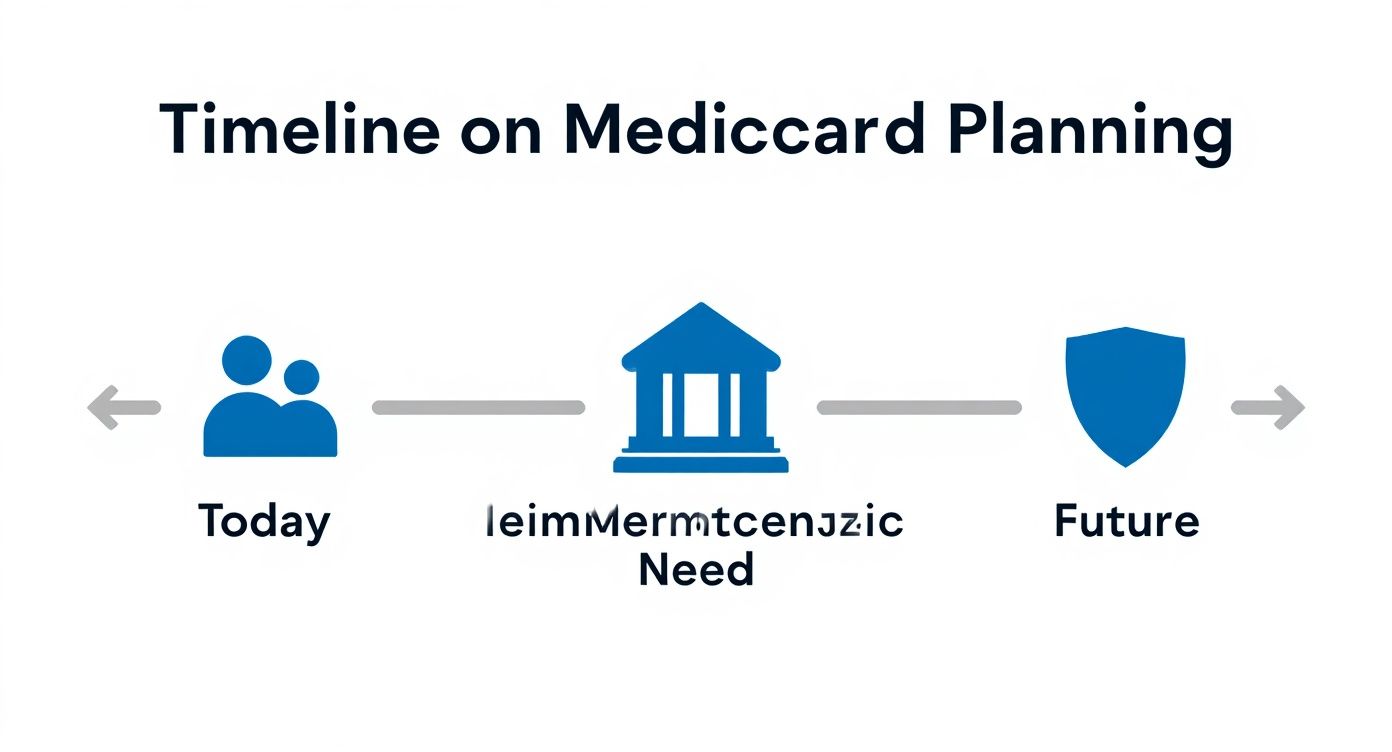
As you can see, the look-back period is the main hurdle you have to clear. Getting from that initial planning stage to a secure future takes real foresight.
A Real-World Texas Scenario: The Well-Intentioned Gift
Let’s walk through a realistic situation we see often with Texas families. Three years ago, Margaret, a retired teacher in Dallas, gave her grandson Alex $60,000 to help him buy his first home. It was a proud family moment, and nobody gave it a second thought.
Fast forward to today. Margaret suffers a severe stroke and now requires around-the-clock nursing home care. The family applies for Medicaid to help with the cost, which is about $7,500 a month. During the application process, Medicaid’s review uncovers that $60,000 gift to Alex.
Because the gift happened inside the five-year window, Medicaid is going to impose a penalty.
How the Penalty Period Is Calculated
The penalty isn’t a fine you pay. It’s a period of ineligibility where Medicaid won't pay a dime for care. They calculate this by taking the total value of the gift and dividing it by the average monthly cost of nursing home care in Texas. This number is called the "penalty divisor," and it gets updated regularly.
Let's use $7,500 as the Texas penalty divisor.
- Step 1 (Identify the Gift): Margaret gifted $60,000 to Alex.
- Step 2 (Divide by the Penalty Divisor): $60,000 ÷ $7,500 = 8 months.
- Step 3 (The Result): This means Medicaid will refuse to cover Margaret’s care for eight full months.
And the clock doesn't start from the day she gave the gift—it starts the day she is otherwise eligible for Medicaid and has applied. For those eight months, her family is on the hook for the entire $60,000 nursing home bill out-of-pocket. A well-intentioned gift, made without understanding the rules, can create a devastating financial crisis at the worst possible time. This is exactly why getting professional legal guidance is essential to protect your family's future.
Using Trusts to Safeguard Your Legacy

When we talk about serious, long-term asset protection, trusts are one of the most powerful tools in the playbook. The word "trust" might sound intimidating, but the idea is actually pretty simple. Think of it as creating a secure legal "box" where you can place high-value assets like your home, land, or an investment portfolio.
The whole point is to legally separate those assets from your personal ownership. Once they're held by the trust, Medicaid generally no longer considers them yours when determining eligibility. This is a foundational strategy for protecting assets from long-term care costs and preserving your legacy for your family.
The Power of an Irrevocable Trust
For Medicaid planning, you can't use just any old trust. The specific tool for the job is an Irrevocable Trust, often specifically structured as a Medicaid Asset Protection Trust (MAPT).
That word—"irrevocable"—is the key. It means that once you create the trust and move assets into it, you can't easily change the terms or take the assets back for yourself.
This is exactly what gives the trust its protective muscle. Because you've given up control, Medicaid no longer sees those assets as available resources you could tap into to pay for your care. This distinction is absolutely critical, as Medicaid imposes a strict asset limit—often just $2,000 for an individual. A properly drafted MAPT allows you to get assets out of your name so they become non-countable.
Of course, setting up a MAPT is a proactive move, not a last-minute fix. It’s still subject to the five-year look-back period. Any assets you transfer into the trust must sit there for the full 60 months before you apply for Medicaid to be fully shielded.
A Tale of Two Trusts
While the MAPT is the go-to for planning ahead, it’s useful to know how it compares to other trusts you might hear about. Let's put it side-by-side with another common tool, the Miller Trust.
| Trust Type | Primary Purpose | When It's Used | Key Feature |
|---|---|---|---|
| Medicaid Asset Protection Trust (MAPT) | To protect assets (like a home or savings) from being counted for eligibility. | Years before needing care, to get past the 5-year look-back. | Irrevocable transfer of assets to shield them from long-term care costs and MERP. |
| Qualified Income Trust (QIT) or "Miller Trust" | To manage excess monthly income to qualify for Medicaid. | When an applicant's income is over the limit but not enough to cover care costs. | All income is deposited into the trust, which then pays for care and a personal allowance. |
This table makes it clear: there are specific legal tools for specific problems. A MAPT solves the "too many assets" problem, while a Miller Trust fixes the "too much income" problem. For most Texas families, protecting the family home is priority number one, making the MAPT an essential part of their plan. For more on this, check out our guide on using trusts to manage real estate in Texas and avoid probate.
How a MAPT Works in a Real Texas Scenario
Let’s look at a Houston couple, Robert and Susan. They're in their late 60s, healthy, and their biggest asset is their paid-off home, worth $450,000. They also have around $150,000 in investments. Their goal is simple: make sure that if one of them needs nursing home care down the road, their life savings and the home they built aren't completely wiped out.
They decide to work with an elder law attorney to create a Medicaid Asset Protection Trust. They name their responsible adult daughter, Emily, as the trustee. Here’s how it unfolds:
- Funding the Trust: They transfer the deed to their home and their investment portfolio into the name of the MAPT. Legally, the trust now owns these assets, not Robert and Susan.
- Living in the Home: This is a crucial point—Robert and Susan continue to live in their home exactly as they always have. The trust is set up to allow them to retain the right to live there for the rest of their lives. They still pay the taxes, insurance, and handle the upkeep.
- Starting the Clock: The day those assets are moved into the trust, the five-year look-back clock starts ticking.
Seven years later, Robert suffers an illness that requires him to move into a skilled nursing facility. When Susan applies for Medicaid on his behalf, the $450,000 home and the $150,000 in investments are not counted as available assets. Why? Because they've been safely inside the MAPT for more than five years. By planning ahead, Robert and Susan protected their entire nest egg and ensured their home could be passed to Emily as they always intended.
Protections for a Healthy Spouse at Home
When a loved one needs long-term care, one of the first and deepest fears a family faces is the thought of financial ruin. For married couples, this fear is especially sharp. Will one spouse's need for nursing home care leave the other—the one still living at home—completely impoverished? It’s a heartbreaking and incredibly common worry.
Thankfully, Texas law has specific safeguards in place to prevent this exact scenario. These protections, known as the Spousal Impoverishment Rules, are designed to ensure the spouse remaining at home, referred to as the "community spouse," has enough money and assets to live on securely. It’s a compassionate recognition that a couple's financial life is intertwined, and one person's health crisis shouldn't destroy the other's stability.
The Story of Maria and David
Let's walk through a realistic scenario to see how these rules provide a critical safety net. Maria and David are a retired couple in their 70s living in San Antonio. They’ve built a life together and have a home, a car, and a joint savings account with $200,000. After a sudden decline in his health, David needs to move into a skilled nursing facility.
Maria is terrified. She knows Medicaid's individual asset limit is a paltry $2,000, and she pictures their entire life savings being drained to pay for David's care, leaving her with next to nothing. This is precisely where the spousal protections become a lifeline.
The law allows Maria, as the community spouse, to keep a significant portion of their joint assets. This is done through two key provisions: the Community Spouse Resource Allowance (CSRA) and the Minimum Monthly Maintenance Needs Allowance (MMMNA).
How the Community Spouse Resource Allowance Works
The CSRA is the amount of countable assets the community spouse is allowed to keep, and it's a game-changer. This mechanism is what stands between the community spouse and financial devastation.
For instance, the Community Spouse Resource Allowance (CSRA) allows the at-home spouse to retain up to $157,920 of the couple's combined countable assets. This protection is a stark contrast to the individual asset limit for the applicant, which remains at that tiny $2,000 threshold. You can learn more about these 2025 Medicaid planning figures to stay current.
Let's apply this to Maria and David's situation. With $200,000 in countable assets, the calculation would look something like this:
- Maria would be entitled to keep the maximum CSRA, which is $157,920.
- The remaining $42,080 would be considered David's share of the assets.
- To get David qualified for Medicaid, they would need to spend down that $42,080 until only his $2,000 limit remains.
This means Maria gets to protect over three-quarters of their savings. The remaining amount can then be strategically spent on permissible items—like paying off debts, making home repairs, or prepaying funeral expenses—all without penalty. It’s not about losing the money; it’s about redirecting it wisely.
Protecting the Community Spouse's Income
Just as important as protecting assets is making sure the community spouse has enough income to pay their monthly bills. This is where the Minimum Monthly Maintenance Needs Allowance (MMMNA) comes into play. This rule allows the community spouse to keep a certain amount of the couple's combined monthly income.
If the community spouse's own income is below this threshold, they can receive a portion of the institutionalized spouse's income (like their Social Security or pension) to make up the difference. This prevents a situation where the nursing home spouse's income is entirely consumed by care costs, leaving the at-home spouse unable to afford their mortgage, utilities, or groceries.
While the calculations can be complex and the figures are updated annually, understanding the principle behind these rules provides immense peace of mind. It shows that the system is not designed to leave you with nothing. Instead, with proper guidance, you can navigate these rules to secure the best possible outcome for both spouses. This is a critical area where professional help with a Guardianship or estate plan can make all the difference.
Compliant Spend Down and Gifting Strategies

Sometimes, the need for long-term care doesn't announce itself years in advance. It arrives suddenly, leaving no time for the five-year planning strategies we've discussed. When you find yourself over the asset limit but needing to qualify for Medicaid right now, you’ve entered the world of "crisis planning." This situation calls for a compliant spend-down of assets.
This isn't about recklessly burning through savings. It’s a methodical process of converting countable assets into exempt ones or using them for permissible expenses. The goal here is to legally and ethically reduce your financial resources to the $2,000 eligibility threshold in a way that actually improves your or your loved one's quality of life and is fully acceptable to Medicaid.
What Is a Permissible Spend Down?
A spend down involves using excess assets on goods or services that directly benefit the Medicaid applicant or their spouse. Every single transaction must be for fair market value and meticulously documented. You're not trying to hide money; you're strategically reallocating it for immediate needs.
This process is an absolute lifeline for families who thought it was too late to plan. It can mean the difference between qualifying for benefits this month versus months from now, potentially saving thousands in out-of-pocket care costs.
A Practical Checklist for Spending Down Assets
When a family is facing a healthcare crisis, knowing where to direct funds can feel overwhelming. Here are common, allowable ways to spend down assets in Texas to meet Medicaid eligibility:
- Step 1: Pay Off Debts: Eliminating a mortgage, car loan, or credit card balances is a primary and highly effective strategy. This move reduces debt and converts countable cash into home equity or a paid-off vehicle—both of which are often exempt assets.
- Step 2: Prepay Funeral and Burial Expenses: Purchasing an irrevocable prepaid funeral plan for both the applicant and their spouse is a fully exempt and very common expense.
- Step 3: Make Home Modifications: Spending money to make a home safer and more accessible is completely permissible. Think about installing a wheelchair ramp, adding grab bars in the bathroom, or even putting in a stairlift.
- Step 4: Purchase or Repair a Vehicle: Buying a new or newer, more reliable vehicle is allowed. You can also spend funds on necessary repairs for an existing car to ensure it's safe.
- Step 5: Invest in Personal Needs: This can include buying new clothing, a television, or furniture for the applicant's room in the nursing facility. Medical equipment not covered by Medicare, like an upgraded wheelchair or specialized bed, is also a valid and important expense.
Each of these actions serves a dual purpose. It helps a loved one qualify for essential care while also providing tangible benefits that enhance their dignity and comfort during a difficult time.
A Critical Warning About Gifting
It is absolutely vital to understand that gifting is almost never part of a crisis spend-down plan. This is a common and costly mistake. Many people confuse the annual IRS gift tax exclusion (currently over $18,000 per person) with Medicaid rules. They are not related.
For Medicaid purposes, giving away any amount of money or property for less than fair market value during the five-year look-back period can trigger a devastating penalty period. Even a $500 check to a grandchild for their birthday can create eligibility problems.
This is especially true when it comes to high-value assets like a house. Many families wonder about the best ways to transfer a home, and it's essential to understand the implications. We explore this in our guide covering five ways to give your house to your kids, but this is a long-term strategy, not a crisis solution.
Key Insights for Texas Families
Let's be honest: navigating Medicaid's rules feels like trying to solve a puzzle with half the pieces missing. But protecting your family's financial future isn't just possible—it's something you can absolutely achieve with the right strategy.
Key Insight: Smart Medicaid planning isn't just about qualifying for benefits today. It's about protecting your legacy for tomorrow. Legal tools like irrevocable trusts can shield your home from both the initial eligibility count and from the state's recovery efforts after you're gone.
First and foremost, planning ahead is the single most powerful tool you have. That five-year look-back period isn't a suggestion; it’s a hard and fast rule. Acting early is the key to making sure that rule works for you, not against you.
Second, these rules are intentionally complex. You are not meant to figure this out alone over a weekend with a search engine. Trying to go it alone often leads to heartbreaking and costly mistakes. A seasoned elder law attorney has seen it all and can give you a clear, step-by-step roadmap to follow. This process can be deeply emotional, but having a solid, legally sound plan brings a sense of stability when everything else feels uncertain.
At the end of the day, the goal is simple: ensure your loved one gets the best care possible without sacrificing the legacy you’ve spent a lifetime building. With a thoughtful plan, you can do both.
Common Questions About Asset Protection
When it comes to protecting your life's savings from long-term care costs, families often have the same pressing questions. Let's tackle some of the most common ones we hear from our Texas clients.
Can Medicaid Take My Home in Texas?
This is a big one, and the answer isn't a simple yes or no. While you or your spouse are living in your primary home, it's generally considered an exempt asset. This means Medicaid won't force a sale for you to qualify for benefits. That's the good news.
But here's the catch: that protection isn't permanent. After the Medicaid recipient passes away, the state can come knocking. Through the Medicaid Estate Recovery Program (MERP), they can make a claim against the estate to get back what they paid for care. This is how many families end up losing the family home through the Texas Probate Process.
Proper planning, often involving a Medicaid Asset Protection Trust, is the only sure way to shield the home from both the initial eligibility count and a future MERP claim.
How Much Money Can I Gift Without a Penalty?
This is where a huge, and costly, misconception comes into play. Many people confuse the annual IRS gift tax exclusion (currently over $18,000 per person) with Medicaid's rules. They are completely unrelated.
Let me be clear: for Medicaid purposes, any gift or transfer for less than what it's worth can trigger a penalty. It doesn't matter if it's $100 or $10,000. Giving away assets within the five-year look-back period will almost certainly result in a period of ineligibility.
Before you even think about gifting money to your kids or grandkids, you absolutely must speak with an elder law attorney to avoid what could become a Probate Litigation issue later.
Is It Too Late to Plan?
It's almost never too late, but your options definitely shrink once a crisis hits and a loved one is already in or about to enter a nursing home. We call this "crisis planning."
Even at this late stage, we can still make a significant difference. Strategies might include:
- Spending down assets on exempt items like home repairs or a new vehicle.
- Purchasing a special type of annuity that is compliant with Medicaid rules.
- Using spousal protection rules under the Texas Estates Code, Title 3, to safeguard assets for the healthy spouse.
A consultation can quickly show you what moves are still on the table. While these Medicaid strategies are crucial, a complete plan for securing your financial future might also include looking into options like asset protection insurance.
If you’re facing probate in Texas, our team can help guide you through every step — from filing to final distribution. Schedule your free consultation today.

